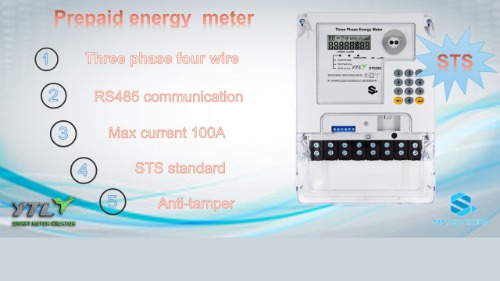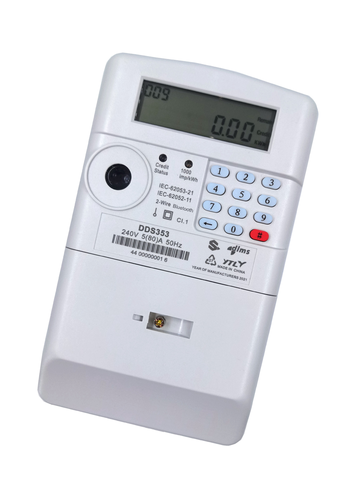A prepayment energy meter, which is an advanced electronic energy meter, is mainly used to measure the consumption of electrical energy in low-voltage circuits. It combines prepaid and smart metering technology, has the characteristics of automation, high precision, and intelligence, and is widely used in homes, commercial, and industrial places. The advantages of prepayment energy meters are outstanding, and they have also played a significant role in actual usage and have been welcomed by the majority of users.
The role of prepayment energy meters
Firstly, the role of prepayment energy meters is that they operate on a prepaid system where users must purchase a predetermined amount of electricity in advance before using it. When the electricity runs out, the meter will automatically cut off the power to avoid accumulating any arrears on your electricity bill. This mechanism of paying for electricity first and using it later can effectively avoid the problem of difficulty in charging, ensuring a benign and sustainable operation of power usage.
The prepayment energy meter integrates a microprocessor, communication interface, memory, and other components that enable it to perform high-precision energy measurements, power parameter measurements, power quality monitoring, and other functions. Through the communication network, the prepayment energy meter can achieve remote meter reading and monitoring, as well as automate and enhance the intelligence of power management.
Prepayment energy meters can intelligently dispatch electricity usage based on the user's consumption habits, optimize electricity usage methods, and reduce electricity bills. For example, the meter can automatically adjust electricity consumption based on the difference in electricity prices during peak and trough periods, thereby reducing electricity costs. At the same time, users can also take targeted energy-saving measures to improve electricity efficiency based on the power parameters and electricity consumption data provided by the meter.
The working principle of prepayment energy meters
Second, the working principle of prepayment energy meters is as follows:
Prepayment energy meters are designed electronically and operate on the basis of high-precision adc (analog-to-digital converter) and microprocessor technology.
Here is how prepayment energy meters work:
- The user purchases a certain amount of electricity and enters the meter by swiping their card or pressing buttons, etc. A microprocessor inside the meter checks and records the amount of electricity that is used.
- The meter measures electrical energy and stores data. Prepayment energy metersaccurately measure a user's electricity consumption and store the results in internal memory. At the same time, the meter also reads the measurement data at regular intervals according to pre-set intervals.
- The meter automatically cuts off and restores the power supply when it runs out of energy. When the prepayment energy meter has been used up, it will automatically cut off the power and stop supplying it to the user. When a user purchases electricity again and inserts the meter, it will automatically restore power.
- Data transmission and remote monitoring of prepayment energy meters can be connected to the communication network through a communication interface. The power parameters and electricity consumption data can then be transmitted to the power management center, allowing for remote monitoring and data analysis.

The advantages and disadvantages of prepayment energy meters
Thirdly, the advantages and disadvantages of prepayment energy meters are as follows:
1.advantages:
- High degree of automation:
The prepayment energy meter integrates microprocessors, memory, and other components that can carry out automatic energy measurement and data storage. This greatly improves the efficiency and accuracy of power management.
- Save manpower and material resources:
The prepayment system of prepayment energy meters can avoid power outages caused by electricity arrears, and reduce the workload of manual collection of electricity bills. At the same time, remote meter reading and remote monitoring functions can realize the automation and intelligence of power management, thereby reducing the investment in manpower and material resources.
- Energy-saving and consumption reduction:
The intelligent scheduling function of prepayment energy meters can optimize electricity consumption modes and reduce electricity costs. At the same time, users can also take targeted energy-saving measures to improve energy efficiency based on the power parameters and electricity consumption data provided by the meter.
2. Disadvantages:
Prepayment energy meters have a higher technical content and a relatively high price, which may increase the initial investment for users.
- High dependence on the network:
Prepayment energy meters require data transmission and remote monitoring with the power management center through the communication network. If the network is faulty or unstable, the additional functionality of prepayment energy meters may be affected.
Prepayment energy meters are advanced and efficient power metering and management devices that are widely used in homes, commercial, and industrial sites. It combines prepaid and smart metering technology to not only achieve high-precision energy metering but also provide power parameter measurement, power quality monitoring, and other functions. Through the communication network, the prepayment energy meter can realize remote meter reading and monitoring, providing a more efficient and reliable means for managing energy usage and tracking electricity consumption.


 English
English 中文简体
中文简体
.png?imageView2/2/w/500/h/500/format/png/q/100)


.jpg?imageView2/2/w/500/h/500/format/png/q/100)




.jpg?imageView2/2/w/500/h/500/format/png/q/100)

.jpg?imageView2/2/w/500/h/500/format/png/q/100)



